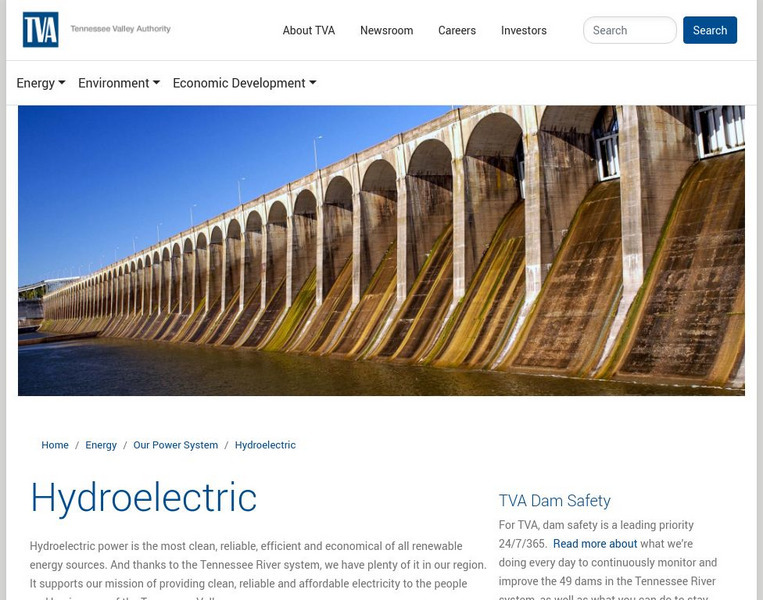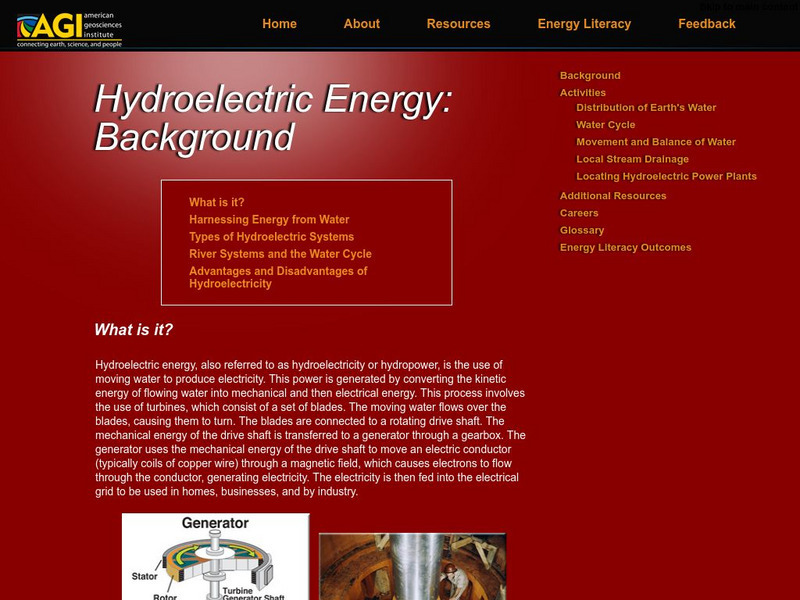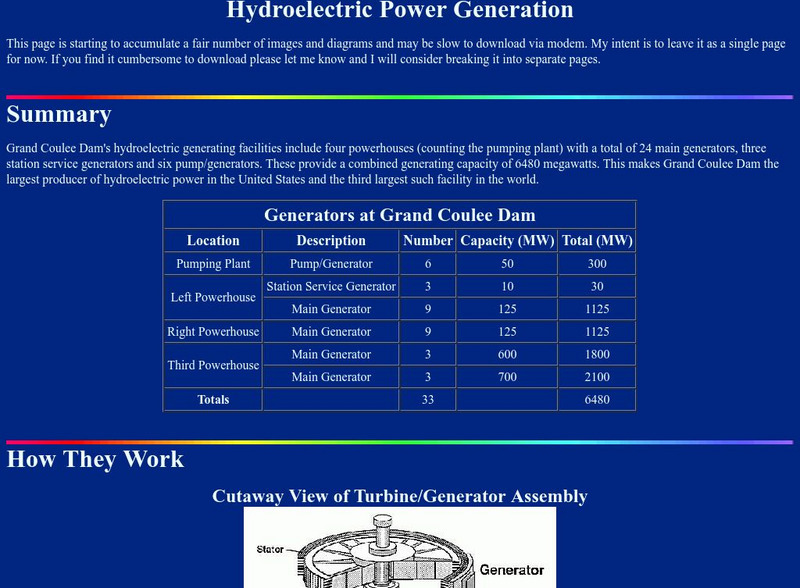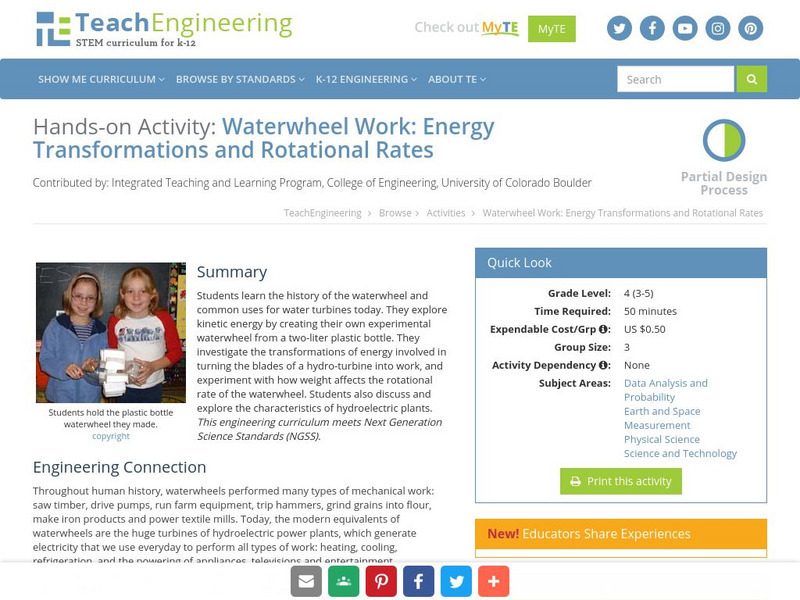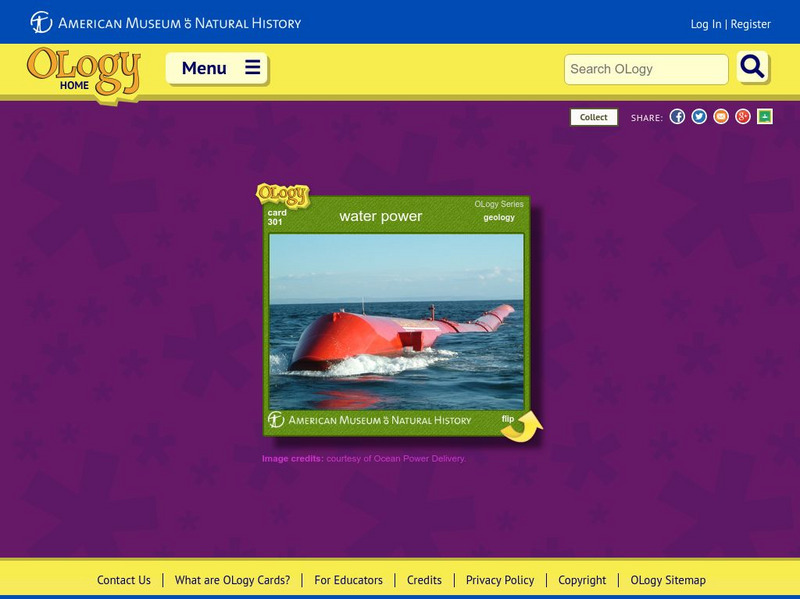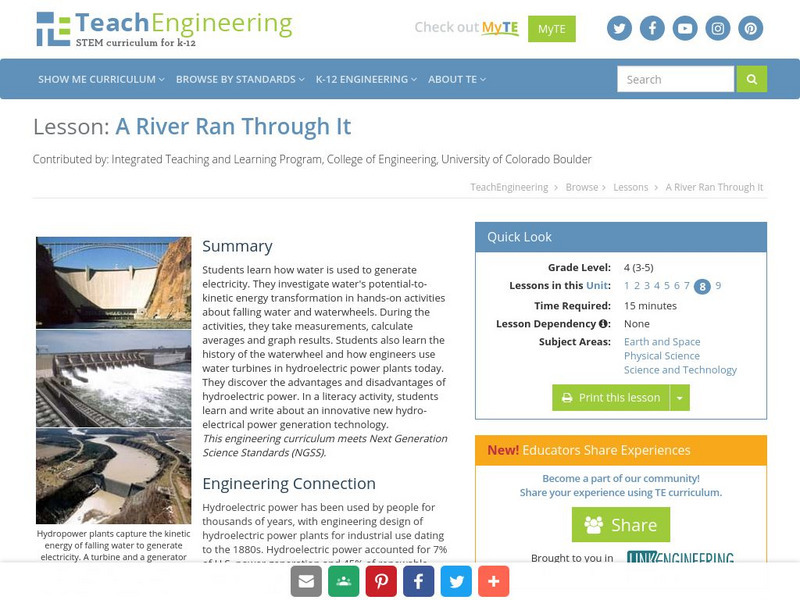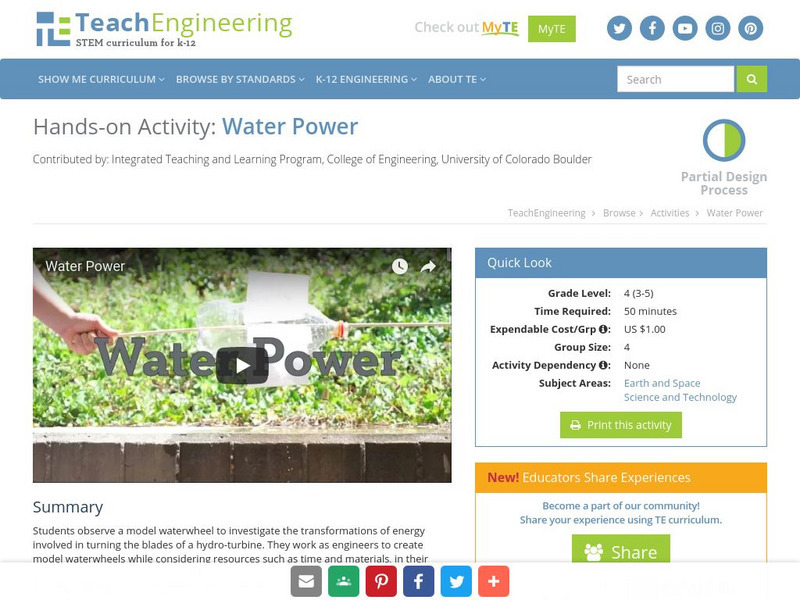Library of Congress
Loc: America's Story: The World's 1st Hydroelectric Plant
This three-page article explores the operation of the first hydroelectric power plant and the spread of renewable energy in the United States.
TeachEngineering
Teach Engineering: Clean Energy: Hydropower
Hydropower generation is introduced to students as a common purpose and benefit of constructing dams. Through an introduction to kinetic and potential energy, students come to understand how a dam creates electricity. They also learn the...
National High Magnetic Field Laboratory
Magnet Academy: Hydroelectric Power Station 1882
The first hydroelectric power plant, known as the Vulcan Street Plant, was powered by the Fox River in Appleton, Wisconsin.
Other
Lesson Plan: Generate Your Own Hydropower [Pdf]
In this online lesson plan, students will generate their own hydropower demonstrating how power is converted to electricity.
Energy4Me
Energy4me: Hydropower
Learn the history of the use of hydroelectricity, and find out how it works to convert water power into electrical power.
Other
Tennessee Valley Association/ Hydroelectricity
Facts and information about hydroelectric power in the Tennessee Valley. Diagrams and schematics of a hydroelectric power plant provided.
US Energy Information Administration
U.s. Eia Energy Kids: Timelines: Hydropower
Learn about key milestones in the use of hydropower, as a source of energy, beginning with its use by the ancient Greeks to grind grains.
American Geosciences Institute
American Geosciences Institute: Hydroelectric Energy: Background
A resource page on hydroelectric energy. Learn what hydroelectric energy is, how it harnesses energy from water, different types and advantages and disadvantages.
Other
Charles Hubbard: Hydroelectric Power Generation
Describes the process of hydroelectric power generation very well. Includes drawings of turbines, pictures of actual turbines and a nice schematic of a dam/turbine system.
Science Buddies
Science Buddies: Put Your Water to Work: Using Hydropower to Lift a Load
Water creates a lot of energy, just look at the Grand Canyon. In this science fair project, you will demonstrate the power of water by converting the kinetic energy in moving water to mechanical energy, which will lift a small weight.
TeachEngineering
Teach Engineering: Waterwheel Work
Students learn the history of the waterwheel and common uses for water turbines today. They explore kinetic energy by creating their own experimental waterwheel from a two-liter plastic bottle. They investigate the transformations of...
TeachEngineering
Teach Engineering: Falling Water
Students drop water from different heights to demonstrate the conversion of water's potential energy to kinetic energy. They see how varying the height from which water is dropped affects the splash size. They follow good experiment...
Ducksters
Ducksters: Environment for Kids: Hydropower Energy
Kids learn about hydropower energy and how this renewable power can help the environment. Teach students about biodiesel, ethanol, and methane gas.
Science4Fun
Science4 Fun: Hydropower
What is hydropower? Discover how electricity is generated from hydropower, three methods of generating electricity, and the advantages and disadvantages.
Technovation
Curiosity Machine: Challenges: Build a Hydroelectric Waterwheel
Can you generate electricity from the flow of water by designing a waterwheel? In this challenge, students will be using everyday objects to create their waterwheel. This site contains a lesson plan, tips, and a place for students to...
American Museum of Natural History
American Museum of Natural History: Water Power O Logy Card
OLogy cards are like virtual baseball cards about all kinds of science topics. This card is about power generated in hydroelectric plants from water. See if you can answer a few questions about water power when you're done reading.
Science Buddies
Science Buddies: Leaky Clues to Dam Design: How Reservoir Height Affects Hydroel
It's hard to believe that the same water that you use every day to quench your thirst, cook with, bathe in, swim in, and wash your clothes and dishes, is capable of another trick-it can make electricity. Electricity can be generated...
US Energy Information Administration
U.s. Eia Energy Kids: Energy Sources: Renewable
Find out what renewable energy is and the role it plays in meeting energy needs. Renewable energy sources include biomass, hydropower, geothermal, wind, and solar.
US Energy Information Administration
U.s. Eia Energy Kids: Energy Sources: Renewable
Learn about renewable energy sources including biomass, which includes biofuels, hydropower, geothermal, wind, and solar.
TeachEngineering
Teach Engineering: Why Do We Build Dams?
Students are introduced to the concept of a dam and its potential benefits, which include water supply, electricity generation, flood control, recreation and irrigation. This lesson plan begins an ongoing classroom scenario in which...
TeachEngineering
Teach Engineering: A River Ran Through It
Students learn how water is used to generate electricity. They investigate water's potential-to-kinetic energy transformation in hands-on activities about falling water and waterwheels. During the activities, they take measurements,...
TeachEngineering
Teach Engineering: Water Power
In this activity, students observe a model of a waterwheel to investigate the transformations of energy involved in turning the blades of a hydro-turbine into work. Students work as engineers to create a model for a new waterwheel while...
CK-12 Foundation
Ck 12: Fourth Grade: Physical Science: Moving Air and Water as Energy Sources
[Free Registration/Login may be required to access all resource tools.] Discusses wind energy and hydroelectric energy.
PBS
Wnet: Thirteen: Ed Online: The Three Gorges: Should Nature or Technology Reign?
This is a site that will combine science and current events. Learners will learn about the Three Gorges hydroelectric project on China's Yangtze River then develop arguments on the benefits or disadvantages of the Three Gorges project....


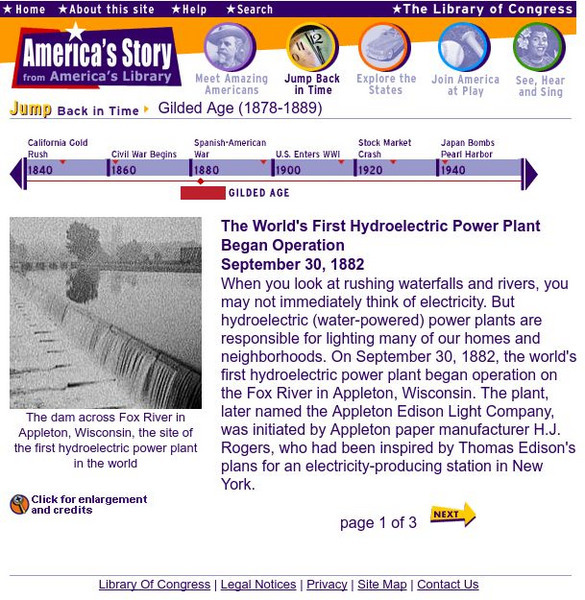
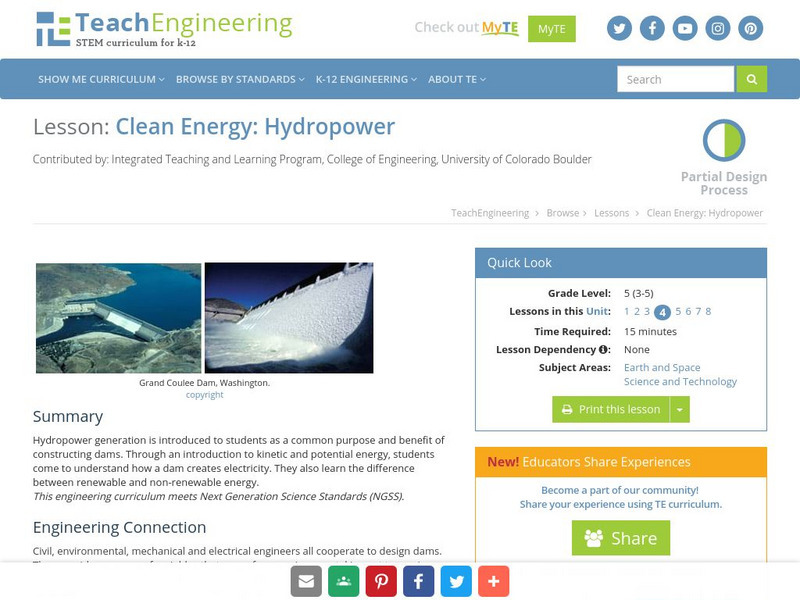
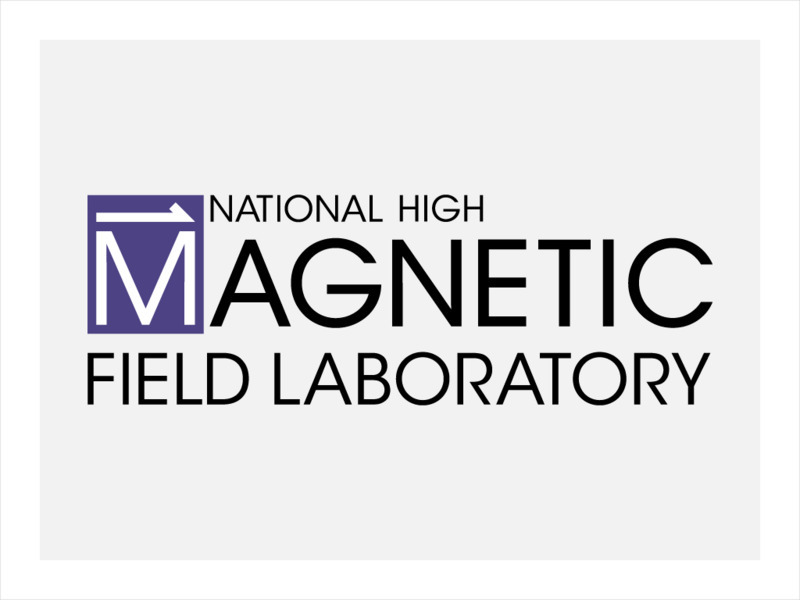
![Lesson Plan: Generate Your Own Hydropower [Pdf] Lesson Plan Lesson Plan: Generate Your Own Hydropower [Pdf] Lesson Plan](https://content.lessonplanet.com/knovation/original/361190-f16bedfd87822a19b49ab449592b0198.jpg?1661256241)

